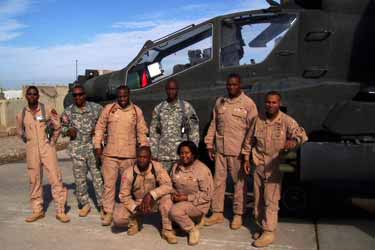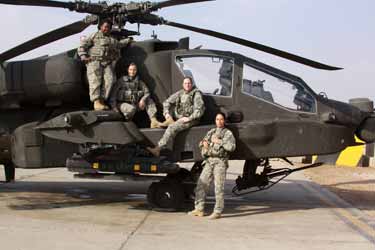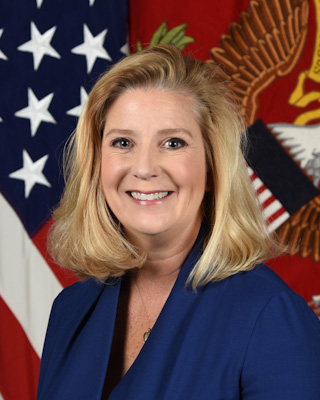Women in the Army Timeline
-
2001 - PFC Sayra Salas Sanchez
Communications Operator Supporting Special Forces
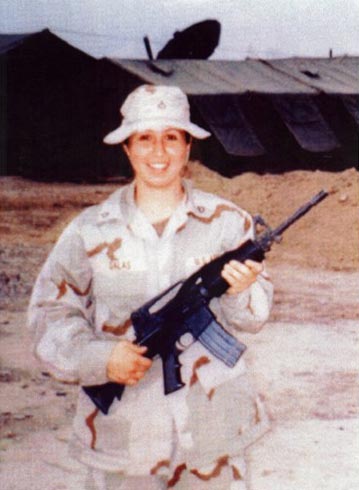
PFC Sayra Salas Sanchez at her base in Afghanistan in 2001. Note the satellite dish above the tent in the background. —Military Women’s Memorial 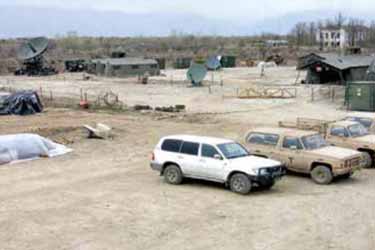
Camp Abel at Bagram Airbase where Sanchez and the 3rd Special Forces Group set up. —Veritas, Volume 12, Number 2 (2016) 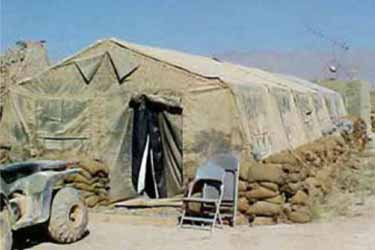
Tent that housed the CJSOTF-A Base Defense Operations Center (BDOC). —Veritas, Volume 12, Number 2 (2016) 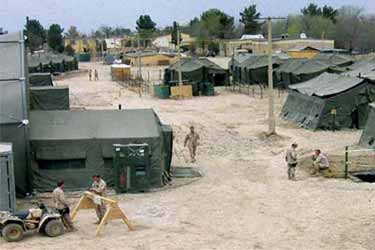
The operations center for the Combined Joint Special Forces Operations Task Force-Afghanistan (CJSOTF-A) —Veritas, Volume 12, Number 2 (2016) Private First Class Sayra Salas Sanchez joined the Army in 2000 and was assigned as a 74C, a telecommunications operator and maintainer with the Third Special Forces Group. She was driving a Zodiac boat during a water jump exercise at Ft. Bragg when her unit received word of the September 11th attacks. Sanchez deployed to Afghanistan in support of the Special Operations Forces. She was one of the first females on the ground with her unit as they began to set up a support base. Working to establish and maintain the communications network in a rough environment, and with incoming enemy mortars, Sanchez helped to ensure reliable communication with the special operations forward bases. Sanchez deployed to Afghanistan a total of three times in four years.
- Resources
- PFC Sanchez’s Oral History Transcript(2005 - PDF Download)
- A Short History of Combined Joint Special Operations Task Force-Afghanistan(2016 - PDF download)
- Creating a Combined Joint Special Operations Task Force HQ in Afghanistan(2016 - PDF download)
- Evolution of ARSOF Communications(2008)
-
2002 - CPT Sherry Womack
Medical Officer with Green Berets
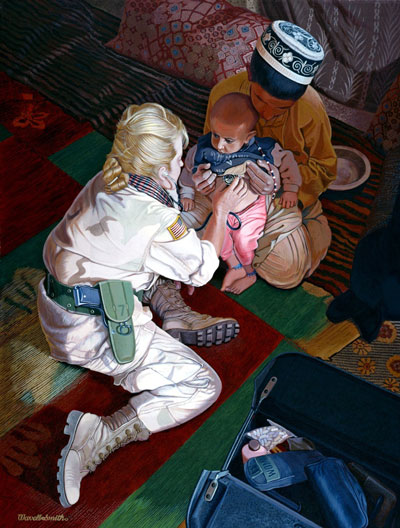
CPT Womack shown treating Afghan civilians in the painting 'Have Stethoscope; Will Travel' by Stewart Wavell-Smith. —U.S. Army Women’s Museum Collection 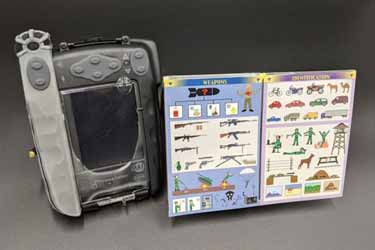
CPT Sherry Womack used new and untested equipment such as this Phraselator when she served with Army Special Forces in Afghanistan. This tool assisted Womack in translating phrases into the local language, Pashto. —U.S. Army Women’s Museum Collection 
CPT Womack providing care for to an Afghan infant. —Courtesy of Sherry Womack 
CPT Womack using the Phraselator while in Afghanistan. —Courtesy of Sherry Womack 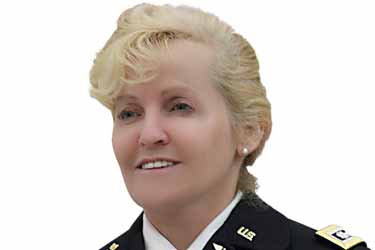
CPT Womack later in her career —Courtesy of Sherry Womack After the attacks on 9/11, some of the first American forces in Afghanistan during Operation Enduring Freedom were the Green Berets. Captain Sherry Womack joined them in January 2002, as a medical support officer, becoming the first female physician’s assistant to accompany Special Operations Forces into a combat zone. Womack worked closely in treating local women and children in a culturally sensitive environment, foreshadowing future Army efforts utilizing women in cultural support. While providing medical care she also gathered intelligence information from local Afghan citizens. Womack served in Afghanistan until August 2002, laying the groundwork for other women to play a key role with connecting to the local population alongside Special Forces operators.
- Resources
CPT Womack: The Smile of Kandahar (2002)
Download video [WMV - 5.05]- “Phrasealator” Helped Womack Communicate(Featured Exhibit)
-
2003 - SSG Kimberly Voelz
Explosive Ordnance Technician (EOD) KIA
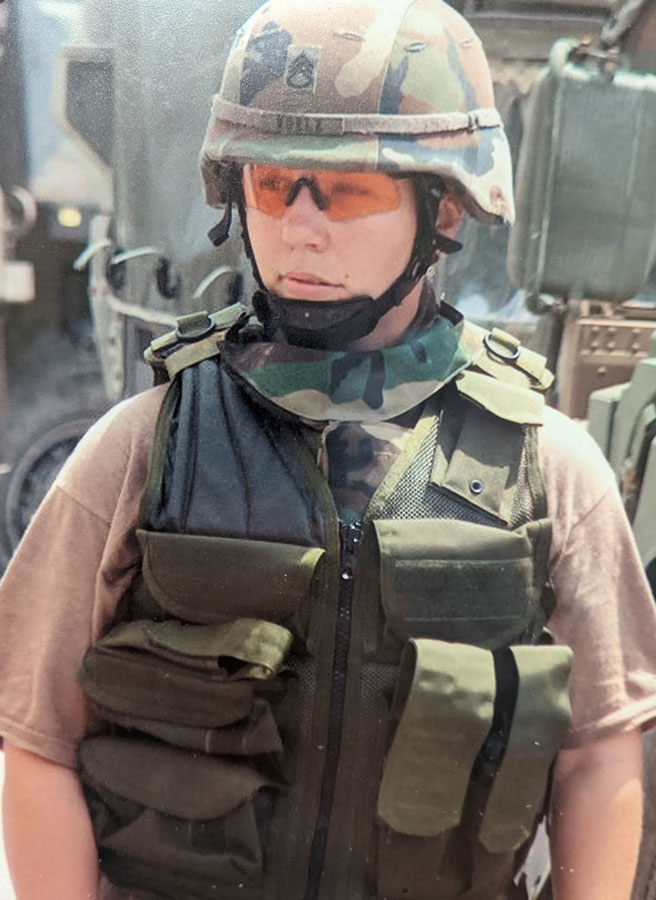
A close up of the photo of SSG Voelz from the memorial plaque at the EOD Training Center at Ft. Lee, Virginia —U.S. Army Women’s Museum Staff Sergeant Kimberly Voelz was assigned to the 703rd Explosive Ordnance Detachment, when it deployed to Iraq in 2003, the only female in her seventeen person unit. An experienced EOD specialist who had served with the Secret Service, Voelz deployed with the same unit as her husband, fellow EOD soldier Staff Sergeant Max Voelz. On December 13, 2003, Max called in the location of an improvised explosive device (IED) and Kimberly was sent to check it out. The IED exploded while she was trying to defuse it, severely wounding her. Voelz died at the hospital several hours later, with her husband by her side. She was posthumously awarded the Bronze Star and Purple Heart.
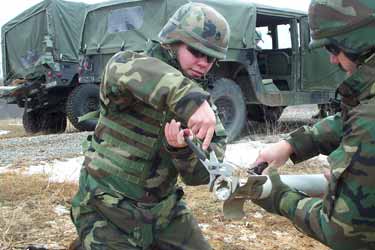
SSG Voelz training at Fort Knox, removing propellant from a 2.75 inch rocket motor. —U.S. Army Women’s Museum 
SSG Voelz with a local dog on the compound while on deployment in Iraq. —U.S. Army Women’s Museum 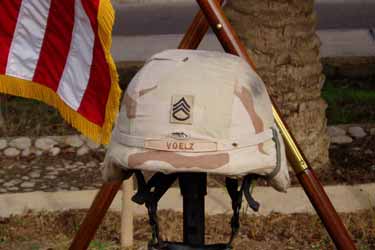
Close up of SSG Voelz’ helmet at memorial service in Iraq. —U.S. Army Women’s Museum 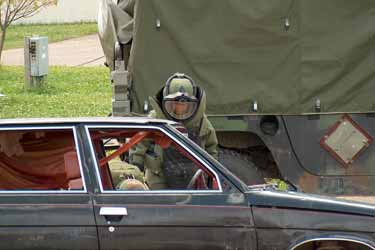
SSG Voelz in a bomb suit during training. —U.S. Army Women’s Museum 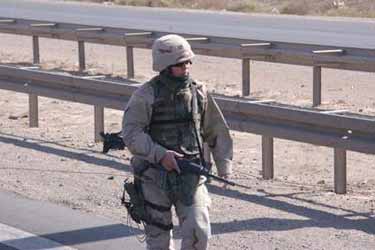
SSG Kimberly Voelz in Iraq. —U.S. Army Women’s Museum 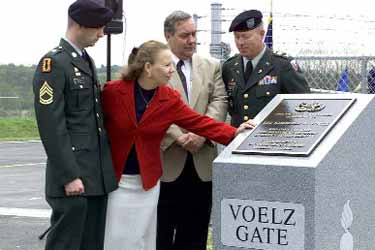
The family of SSG Voelz looks at the memorial stone at the Voelz Gate to Letterkenny Army Depot. An article on the dedication can be found in the “additional resources” section below. —The Sentinel 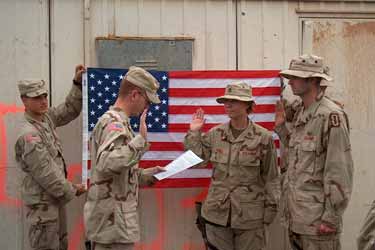
Kimberly and Max Voelz reenlisting together while in Iraq, 2003. —U.S. Army Women’s Museum 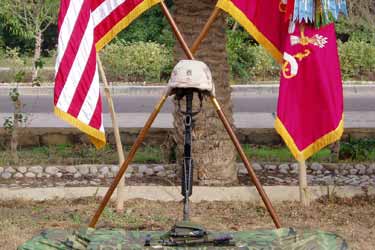
SSG Voelz’ memorial service in Iraq. —U.S. Army Women’s Museum 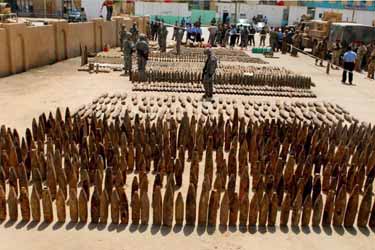
Insurgents in Iraq often used old artillery shells, like the ones seen in this recovered munitions cache, to produce their IEDs. —U.S. Army Photo (DVIDS 92055) -
2004 - CPT Kimberly Hampton
First Female Aviator KIA by Hostile Fire
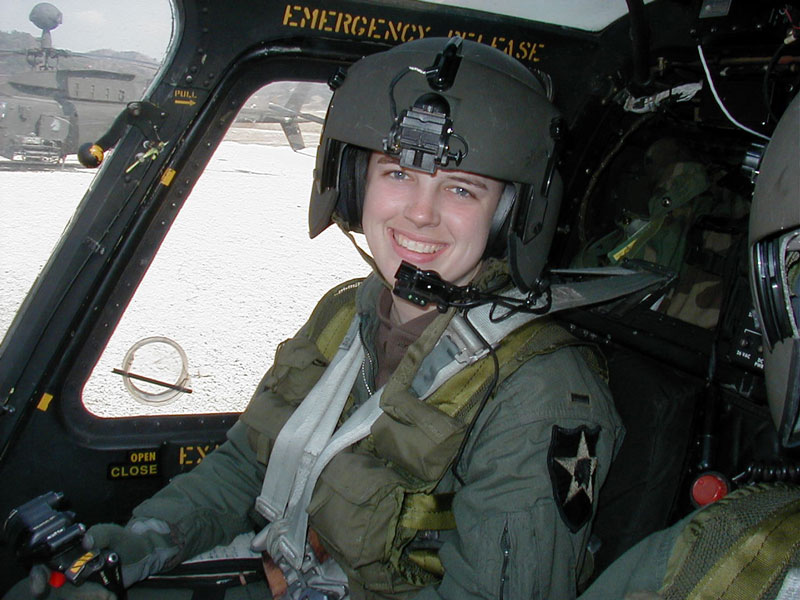
CPT Kimberly Hampton, seen here while stationed in South Korea, was the first female American pilot to be killed by enemy fire. —U.S. Army Photo On January 2, 2004, Captain Kimberly Hampton’s OH-58 Kiowa, an armed reconnaissance helicopter, was shot down by hostile groundfire near Fallujah, Iraq. Hampton died in the crash, making her the first female American pilot to be killed by enemy fire. Well liked as a pilot and leader, Hampton was flying with the 82nd Airborne Division at the time of her death. Before she deployed to Iraq, Hampton left her parents a letter which included, “if anything ever happens to me, you can be certain that I am doing the things I love...So, worry if you must, but you can be sure that your only child is living a full, exciting life and is HAPPY!” Hampton was posthumously awarded the Bronze Star, Air Medal, and Purple Heart.

OH-58 Kiowa helicopters assigned to the 82nd Airborne Division seen near Tallil Airfield, Iraq in March 2003. —U.S. Army Photo (DVIDS 5026594) 
Paratroopers from the 82nd Airborne Division watch an OH-58 Kiowa provide air support in Iraq in April 2003. —U.S. Army photo (DVIDS 5026552) 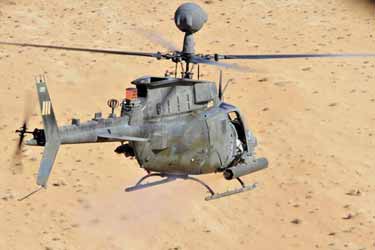
Kiowas often flew low, both to better observe what was happening on the ground and to provide effective support to troops. —U.S. Army Photo (DVIDS 363031) 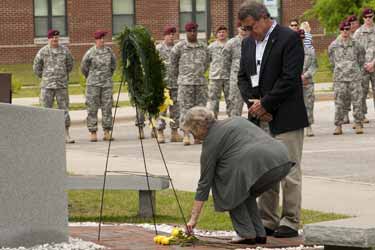
CPT Hampton’s parents place a rose during a ceremony at the 82nd Combat Aviation Brigade Memorial at Fort Bragg, NC in 2013. —U.S. Army Photo (DVIDS 939674) 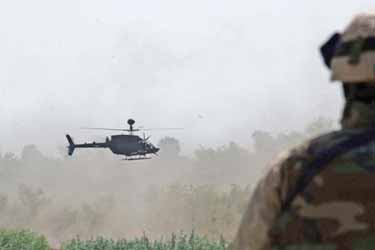
A Kiowa flies low to assess the results of an airstrike in Iraq. —U.S. Army Photo (DVIDS 6849) 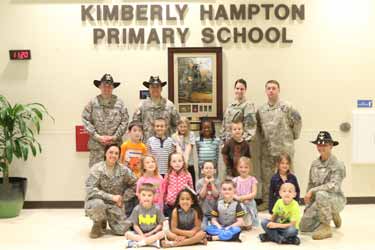
Paratroopers from the 82nd Combat Aviation Brigade with kindergarten students in front of a painting of CPT Hampton at the Kimberly Hampton Primary School in 2015. —U.S. Army Photo (DVIDS 1908697) -
2005 - SGT Leigh Ann Hester
First Female Silver Star Recipient for Combat
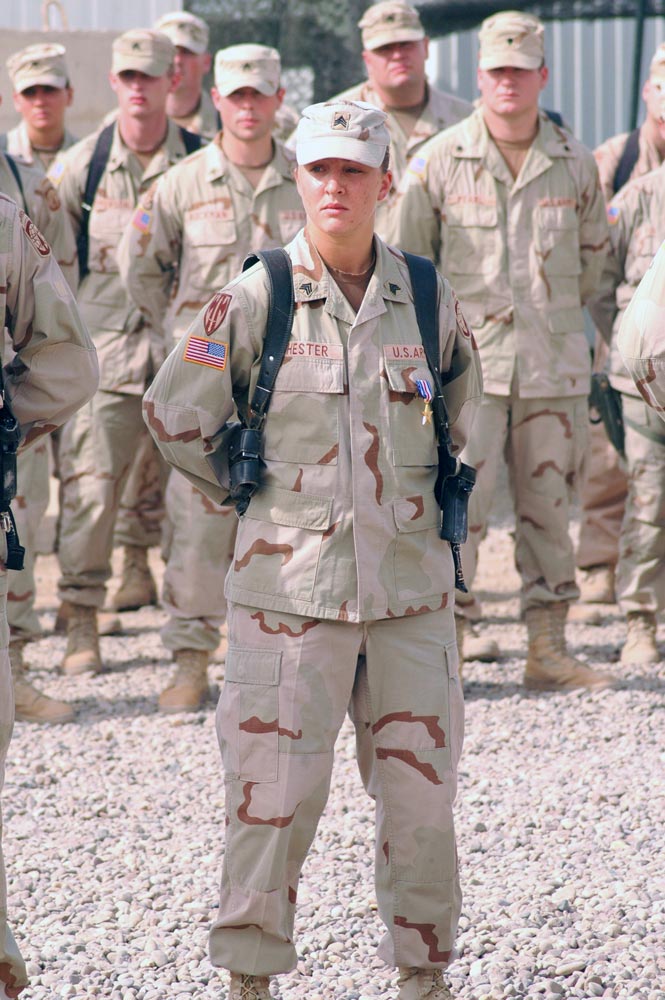
SGT Leigh Ann Hester standing in formation after having been awarded the Silver Star for her actions on March 20, 2005. —U.S. Army Photo (DVIDS 6996) On the morning of March 20, 2005, over fifty insurgents launched a large scale ambush on a convoy near Baghdad, Iraq. The 617th Military Police Company, a Kentucky National Guard unit, was escorting the convoy. Among the Soldiers was Sergeant Leigh Ann Hester, who positioned her Humvee in a flanking firing position as the Americans responded to the ambush. After directing her gunner and firing grenades, Hester followed her squad leader, Staff Sergeant Timothy Nein, and together they cleared two trenches of insurgents. The actions of Hester and her unit broke the ambush and resulted in heavy insurgent casualties. For her actions that day, Hester was awarded the Silver Star, becoming the first woman since World War II to receive the medal, and the first woman ever to receive the award for direct combat action.
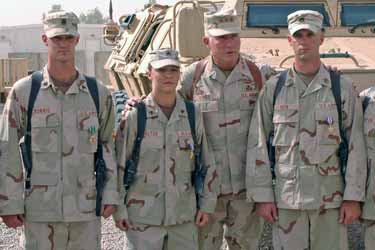
SGT Hester with her fellow Soldiers of the 617 Military Police after their award ceremony for repelling the insurgent ambush on March 20, 2005. —U.S. Army Photo 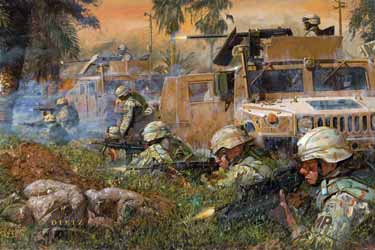
This painting called Raven 42, shows the firefight between Hester’s squad and insurgents on March 20, 2005. --Raven 42, a National Guard Heritage Painting by James Dietz, courtesy of the National Guard Bureau 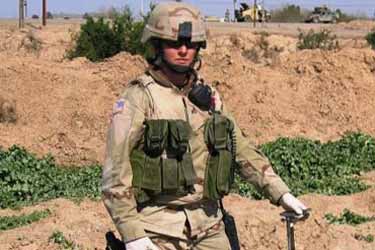
SGT Hester holding a captured AK-47 after the ambush on March 20, 2005. —U.S. Army Women’s Museum 
SGT Leigh Ann Hester standing in formation after having been awarded the Silver Star for her actions on March 20, 2005. —U.S. Army Photo (DVIDS 6996) 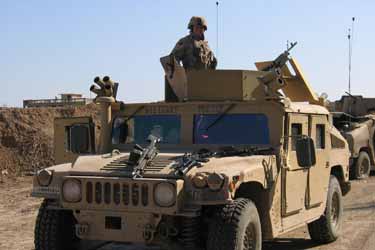
SGT Hester standing in her Humvee. —U.S. Army Women’s Museum 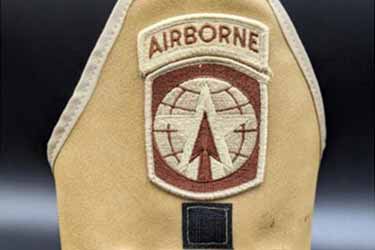
Military Police Brassard – This brassard is part of a group of artifacts donated by Soldiers of the 503rd Military Police Battalion. SGT Leigh Ann Hester served with this unit when she was awarded the Silver Star. —U.S. Army Women’s Museum Collection 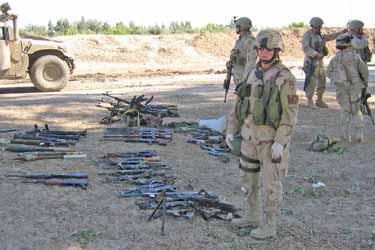
SGT Hester standing by captured weapons on March 20, 2005. —U.S. Army Photo (DVIDS 4355) 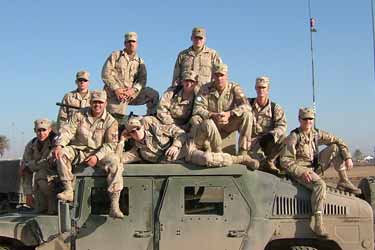
SGT Hester (far right) with her team. —U.S. Army Women’s Museum 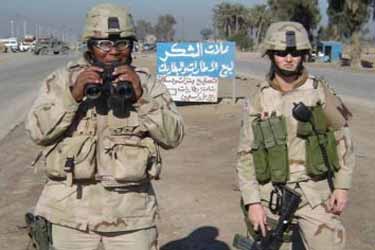
SGT Hester seen wearing this type of brassard along an Iraqi highway. Next to her is SPC Mike, the unit medic, who also was awarded a Silver Star for actions on March 20, 2005. —U.S. Army Women’s Museum Collection - Resources
- Hester Heroics Celebrated(2020)
- Hester being awarded Silver Star(2005)
- Hester Awarded Silver Star(2005)
- Silver Star Recipients Look Back on Ambush(2006)
- Reluctant hero: Hester Recalls Combat Actions(2011)
- Full citation for Silver Star
- Photo Gallery of the Aftermath of Ambush on March 20, 2005
-
2006 - CW2 Sheila Pressley
AH-64 Apache Attack Helicopter Pilot
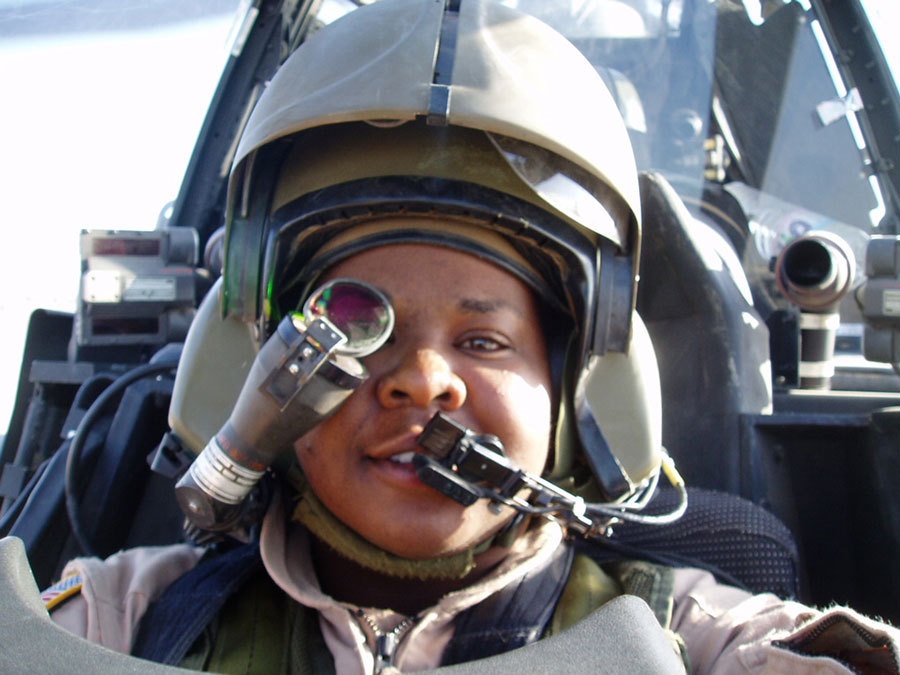
CW2 Pressley seen in the cockpit of an AH-64 Apache after a reconnaissance/convoy security mission in Iraq during 2003. At the time she was flying from Balad airfield north of Baghdad with C Company, 6th Squadron, 6th Cavalry Regiment. —U.S. Army Women’s Museum Chief Warrant Officer Two Sheila Pressley deployed to Iraq three times between 2003 and 2009 during Operation Iraqi Freedom. She later deployed to Afghanistan in 2012 during Operation Enduring Freedom. During 2006, Pressley flew missions with 1st Battalion, 4th Aviation Regiment, 4th Infantry Division at Taji, Iraq. Throughout her career, Pressley succeeded in ever challenging roles, including Pilot-in-Command and Air Mission Commander, retiring as a Chief Warrant Officer Three. Reflecting on the discrimination she faced during her time in service, Pressley stated, “My hope is that I’ve torn down some of those walls permanently, so that the next person only need to prove him or herself without first disproving misconceptions regarding their race or gender as being indicative of their individual merit.”
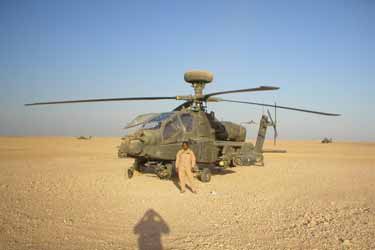
CW2 Pressley standing in front of her AH-64 Apache helicopter at Tactical Assembly Area Vicksburg early in the Iraq war. In 2003 she was part of C Company, 6th Squadron, 6th Cavalry Regiment. —U.S. Army Women’s Museum 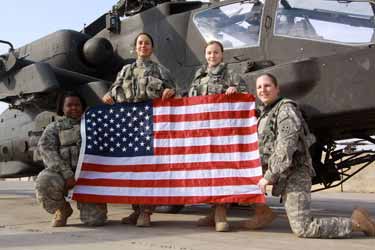
This photo from January 2009 shows (L-R) CW3 Pressley, CW3 Stephanie Rose, CW2 Jenny Neason, and MAJ Tammy Baugh. At the time, Pressley was Air Mission Commander (AMC) with the 1st Battalion, 4th Aviation Regiment, 4th Infantry Division. The aviators believe they flew the first all-female AH-64 Apache sortie in Iraq. —Courtesy of Eduardo Alomar 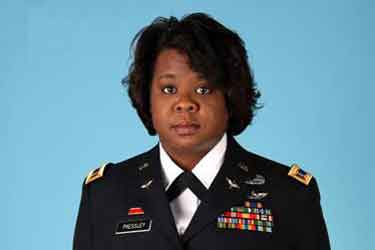
CW3 Pressley seen in dress blue uniform late in her career. —U.S. Army Women’s Museum A photo of all but one of the Black pilots from two battalions at the beginning of CW2 Pressley’s 2005-2006 deployment. This picture was taken when her unit (1st Battalion, 4th Aviation Regiment, 4th Infantry Division) was taking over the mission from the 1st Cavalry Division in Taji, Iraq. The aviators in tan flight suits are (L-R) Felick Vallot, Wesley Hunt, Brian Umstead, Pressley, Roger Stidom, and Joel Coleman. The two pilots from 1st CAV in green flight suits are unidentified. —U.S. Army Women’s Museum This photo from January 2009 shows (L-R) CW3 Pressley, CW2 Jenny Neason, MAJ Tammy Baugh, and CW3 Stephanie Rose. At the time, Pressley was Air Mission Commander (AMC) with the 1st Battalion, 4th Aviation Regiment, 4th Infantry Division. The aviators believe they flew the first all-female AH-64 Apache sortie in Iraq. —Courtesy of Eduardo Alomar 
CW3 Pressley’s flight jacket from later in her career. —U.S. Army Women’s Museum Collection - Resources
African-American Women in Army Aviation
Female Soldiers Continue Footprint in Army Aviation (2009)- “Cleared for Combat” article from Army Times (1993)
-
2007 - PFC Monica Brown
Combat Medic and Silver Star Recipient

PFC Brown was a combat medic who was awarded the Silver Star for her actions in Afghanistan in 2007. —U.S. Army Photo Private First Class Monica Brown was an 18-year old medic from the 782 Brigade Support Battalion, 82nd Airborne Division in Afghanistan. During a patrol with a combat unit on April 25, 2007, Brown showed extraordinary heroism when insurgents ambushed their Humvees. While under fire, Brown and her platoon sergeant ran to a vehicle that had hit an improvised explosive device (IED), pulling wounded Soldiers to cover. During the ensuing firefight, Brown treated the wounded, and twice covered them with her body to protect them from heavy enemy fire. For her actions that day, Brown became only the second female Soldier since World War II to be awarded the Silver Star.
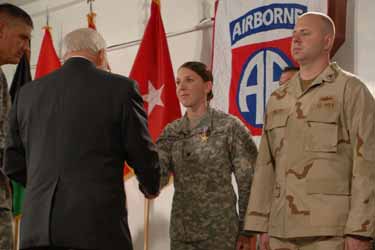
PFC Brown being awarded the Silver Star by Vice President Dick Cheney during a visit to Afghanistan in 2008. —U.S. Army Photo 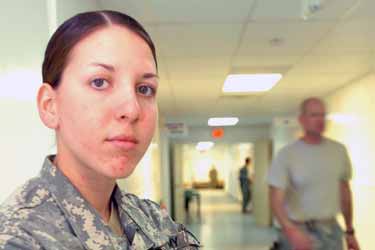
PFC Brown seen in 2008 while serving at Forward Operating Base Salerno’s hospital in Afghanistan. —U.S. Army Photo (DVIDS 81204) 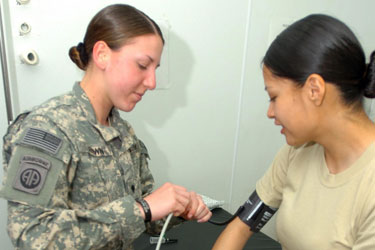
PFC Brown treats a fellow Soldier at Forward Operating Base Salerno’s hospital in Afghanistan. —U.S. Army Photo (DVIDS 81208) 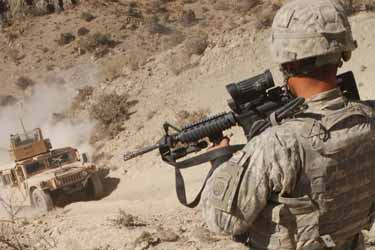
A Humvee from the 782nd Brigade Support Battalion navigates up a steep slope under the eye of a platoon sergeant in 2007. —U.S. Army Photo (DVIDS 62101) 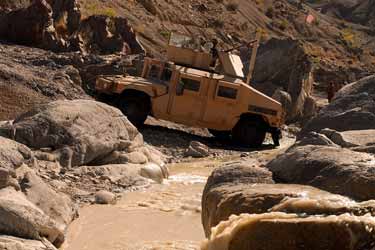
A Humvee from the 782nd Brigade Support Battalion crosses a stream in Afghanistan in 2007. —U.S. Army Photo (DVIDS 62098) - Resources
- PFC Brown Awarded Silver Star (2008)
- Silver Star Recipient Joined Army as Brother Enlisted (2008)
PFC Brown interview and dramatization (2009)
PFC Brown’s Heroic Actions (2009)
- Sergeant Brown Biography
-
2008 - GEN Ann Dunwoody
First Female Four-Star General

GEN Dunwoody smiles as GEN George Casey, Chief of Staff of the Army, and her husband, Craig Brotchie, pin general’s bars on her on November 14, 2008. —Department of Defense Photol On November 14, 2008, General Ann Dunwoody became the first female four-star general in the U.S. Army. Dunwoody commissioned into the Women’s Army Corps (WAC) in 1975, before the branch was disestablished in 1978. During her career, Dunwoody had several firsts in the Army, including serving as the first female battalion commander in the 82nd Airborne Division and the first woman to command the Combined Arms Support Command. When she was promoted to general in 2008, Dunwoody said, “I have never considered myself anything but a Soldier. I recognize that with this selection, some will view me as a trailblazer, but it's important that we remember the generations of women, whose dedication, commitment and quality of service helped open the doors of opportunity for us today.” Dunwoody served with distinction for thirty-seven years.
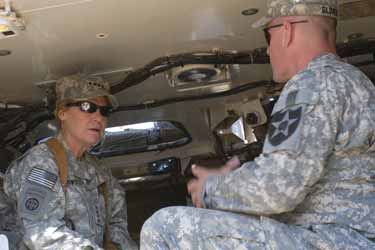
GEN Dunwoody listens to a Soldier explain capabilities of a Stryker armored vehicle during a visit to Iraq. —U.S. Army Photo (DVIDS 263850) 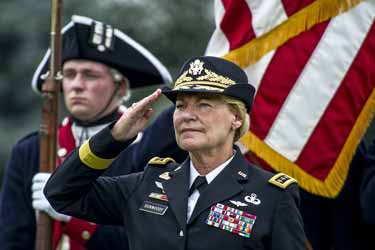
GEN Dunwoody salutes during her retirement ceremony in 2012. —U.S. Army Photo 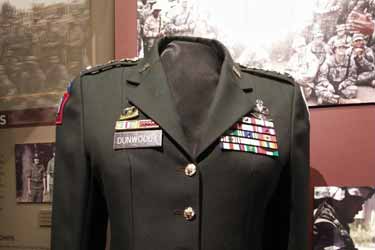
General Dunwoody Service Coat – General Ann Dunwoody wore this service coat while assigned as the Commanding General the Army Material Command (AMC). —U.S. Army Women’s Museum Collection - Resources
- General Dunwoody confirmed as four star (2008)
- Dunwoody Album throughout her career (2008)
-
2009 - CSM Teresa King
First Woman Appointed as Commandant of the Drill Sergeant School
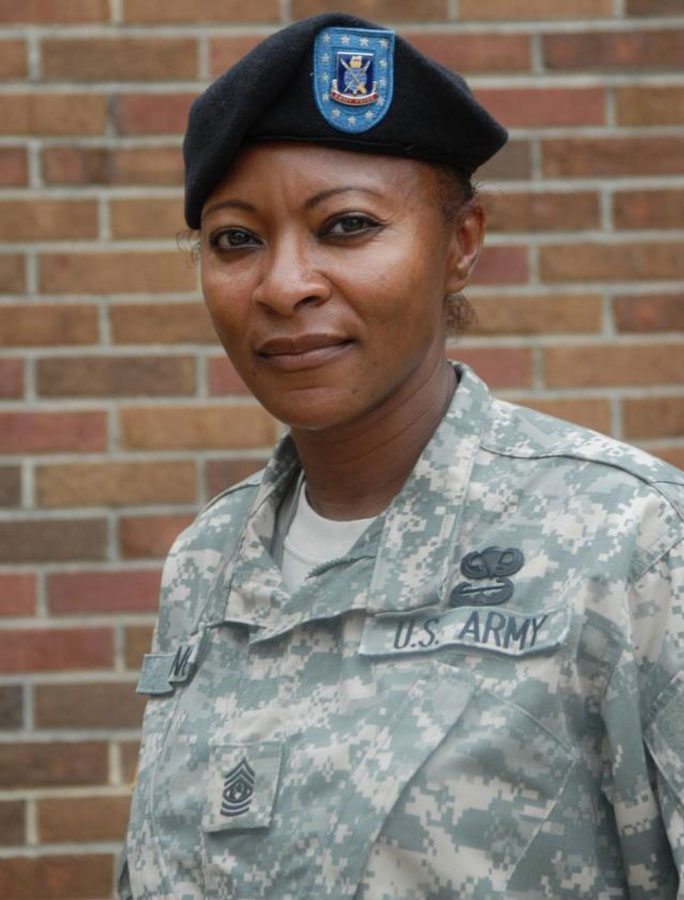
CSM King seen in 2009 after the announcement that she would become the first female commandant of the Drill Sergeant School. —U.S. Army Photo (DVIDS 192526) On September 22, 2009, Command Sergeant Major Teresa King assumed her role as the Commandant of the Drill Sergeant School, becoming the first woman to hold that position. A drill sergeant early in her own career, King rose through the ranks and later became the first woman to serve as first sergeant of HHC, XVIII Airborne Corps. Upon her historic posting to the Drill Sergeant School, King stated, “It really doesn’t matter if you’re male or female. If you . . . enforce standards, people will respect you.”
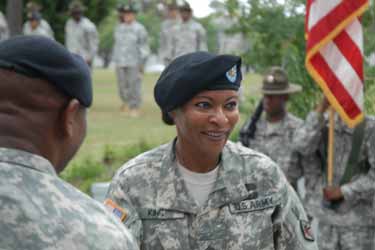
CSM King on the day she became the first female commandant of the Drill Sergeant School. —U.S. Army Photo 
CSM King in her office in 2009. —U.S. Army Photo - Resources
- CSM King Makes History (2009)
- King Hopes Selection Encourages Women (2009)
- King Takes the Reins (2009)
AP News Segment on King’s appointment (2009)
- Inducted into Drill Sergeant Hall of Fame (2017)
-
2010 - SGT Sherri Jo Gallagher
First Woman to Win Soldier of the Year

SGT Gallagher shooting at targets during a qualification test as part of the Soldier of the Year competition. —U.S. Army Photo (DVIDS 331915) In 2010, Sergeant Sherri Gallagher made history by becoming the first female to win the Soldier of the Year competition. Soldiers have to complete a series of tests such as land navigation, first aid, and marksmanship during the competition at Fort Lee, Virginia. Gallagher beat out twenty three other Soldiers to win the prestigious title in October 2010. A competitive shooter from an early age, Gallagher was part of the Army Marksmanship Unit from 2008 until 2012. Besides competing in matches, her job consisted of training soldiers how to shoot, both at basic and advanced levels. Gallagher also deployed to Afghanistan where she trained female Afghanistan Army officers in marksmanship. In 2012, Gallagher joined “The Golden Knights” U.S. Army Parachute Team.

SGT Gallagher receiving the Soldier of the Year trophy. She is flanked by Vice Chief of Staff GEN Peter Chiarelli and SMA Kenneth Preston. —U.S. Army Photo (DVIDS 333163) 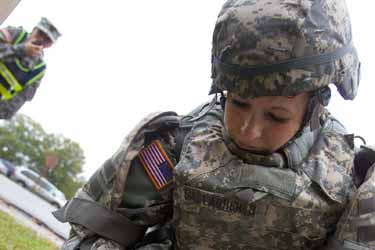
SGT Gallagher works on land navigation as part of the Soldier of the Year competition. —U.S. Army Photo 
Gallagher Cap - This cap was worn by SGT Sherri Jo Gallagher while serving as a 'sharpshooter' with the U.S Army Marksmanship Unit. —U.S. Army Women’s Museum Collection 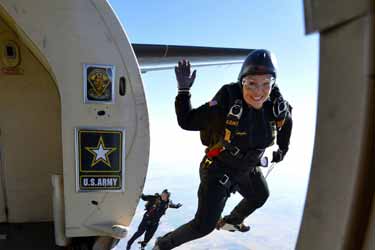
SGT Gallagher waves as she jumps out the plane as a member of the U.S. Army’s Golden Knights in 2016. —U.S. Army Photo (DVIDS 2501541) - Resources
- Gallagher Reflects on Winning Soldier of the Year (2011)
Dream Strong Video (Army Strong) (2012)
Soldier of the Year 2010 competition (2010)
- Gallagher Army Bio Sheet (PDF)
- Gallagher Biography
- Gallagher as part of Golden Knights (2016)
-
2011 - First Cultural Support Teams Deploy
Cultural constraints in Afghanistan led to U.S. Special Operations Command creating the Cultural Support Team (CST) concept in 2010. Many situations required that female Soldiers engage with local populations as it was not suitable for male Soldiers to do so. The CST concept was similar to earlier efforts such as the Team Lioness servicewomen or the Female Engagement Teams (FET) which had been utilized in Iraq and Afghanistan on an ad hoc basis. However, the CST concept was designed as a formal program, and would serve to strengthen Special Forces missions. The first Cultural Support Team deployed in January 2011. First Lieutenant Ashley White was part of the next group, CST-2, when she deployed to Afghanistan six months later. On 22 October, White was out on a night mission with the 2/75th Ranger Regiment when an IED exploded close by, making her the first CST member to be killed in action. At the time of her death, females were banned from combat but could still be attached to Special Operations units in various roles (as seen earlier in the timeline). White was posthumously awarded the Bronze Star and Purple Heart.

A recruiting poster for the Female Engagement Team/Cultural Suport Team program. —U.S. Army Women’s Museum 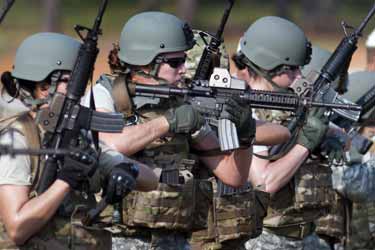
Female Soldiers participate in marksmanship training during the selection process for joining the Cultural Support Team program. —U.S. Army Photo (DVIDS 424878) 
Matthews Archival Collection - These items were donated by SFC Mary Matthews. This archival collection documents Matthews’ experiences in Cultural Support Team (CST) Assessment and Selection, the CST Training Course, and deployment to Afghanistan with CST-4. —U.S. Army Women’s Museum Collection 
Female Soldiers participate in training during the selection process for joining the Cultural Support Team program. —U.S. Army Photo (DVIDS 424879) 
1LT White seen on deployment in Afghanistan. —U.S. Army Photo 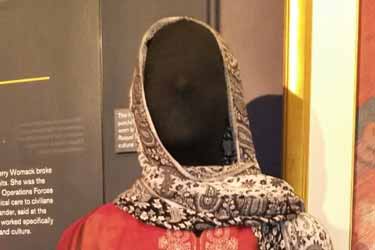
CW4 Patrick - Chief Warrant Officer 4 Patrick wore this tunic and scarf when she was deployed in Afghanistan with a Cultural Support Team. CW4 Patrick wore these items of clothing over her Army uniform when she interacted with the Afghan people in their villages so they could recognize she was a female Soldier. —U.S. Army Women’s Museum Collection - Resources
- Historical Timeline of Cultural Support Teams (2016)
- Blurred Lines: Cultural Support Teams in Afghanistan (2014)
- The Women of the Army Rangers’ Cultural Support Teams (2015)
- 1LT Ashley White’s Obituary (PDF)
- Special Operation Command Bio for 1LT White (PDF)
- White’s twin sister on her service and legacy (2021)
-
2012 - Army Opens Six Combat Related Military Occupational Specialties (MOS)
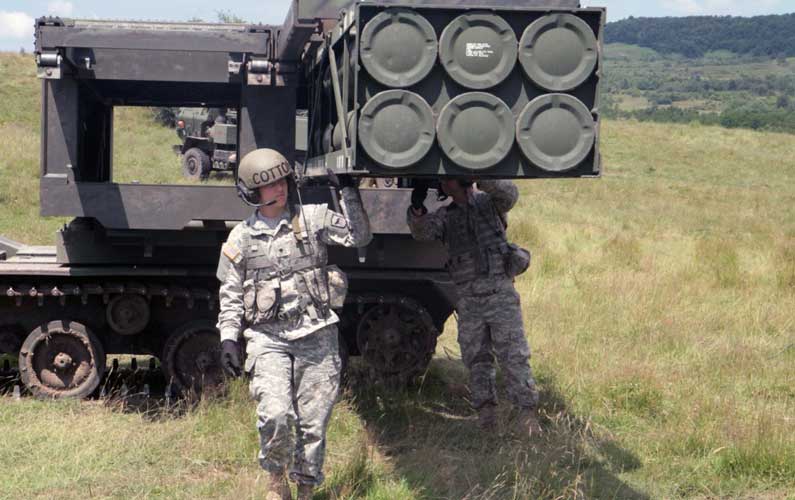
SPC Erika Cotton, part of the 147th Field Artillery Battalion, South Dakota Army National Guard, assists with loading a rocket pod. Cotton was one of the first women to serve with the field artillery unit. The military occupational specialty 13M “Multiple Launch Rocket System crewmember” was one of the jobs opened to women in 2012. —U.S. Army Photo (DVIDS 3928237) In February 2012, the Army stated its plan to open six new jobs to women. These MOSs were typically assigned to or “co-located” with direct combat units and were previously closed to female Soldiers. They included support positions with artillery, armor, and other fighting vehicles. The Army also opened battalion level positions in combat units to women. Both of these developments were in opposition to the 1994 Combat Exclusion Policy, specifically the “co-located” clause which was shown to be archaic in the fluid nature of the modern battlefield. These changes signaled momentum towards a full overturn of the 1994 policy.
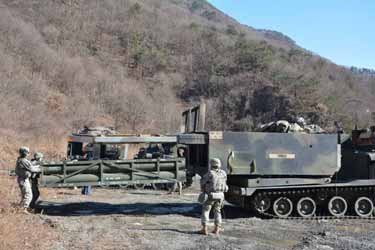
PFC Bailey Hilgers (R) loads rocket pods during an exercise in South Korea. The military occupational specialty 13M 'Multiple Launch Rocket System crewmember' was one of the jobs opened to women in 2012. —U.S. Army Photo (DVIDS 1157951) 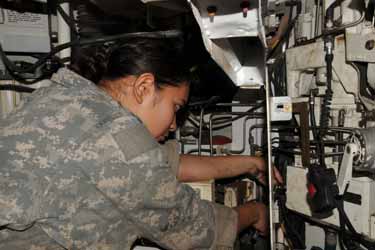
PFC Katherine Garcia performs maintenance on a M1A2 Abrams tank. The military occupational specialty 91A 'M1 Abrams Tank System Maintainer' was one of the jobs opened to women in 2012. —U.S. Army Photo (DVIDS 1627340) 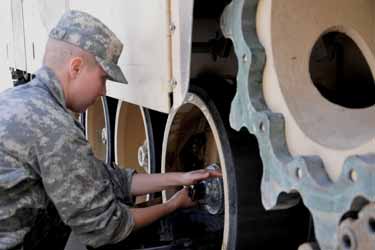
PFC Corrissa Johnson works on a wheel of a M1A2 Abrams tank. The military occupational specialty 91A 'M1 Abrams Tank System Maintainer' was one of the jobs opened to women in 2012. —U.S. Army Photo (DVIDS 1627331) 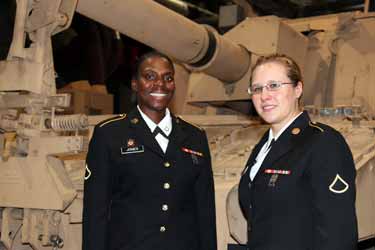
PFC Jessica Jones and PFC Angelika Jansen were the first two female Artillery Mechanics in the Army. The military occupational specialty 91P 'Artillery Mechanic' was one of the jobs opened to women in 2012. —U.S. Army Photo - Resources
- Army Opens Positions to Women (2012)
- Pentagon to Loosen Restrictions on Women in Combat (2012)
- Integrating Army Women Into Combat (2013)
- First Female Bradley Mechanic (2012)
- First Female Bradley Mechanic Trains (2013)
- NCO Corps Welcomes First Female Bradley Maintainer (2015)
- Army Opens More Jobs to Women (2013)
- First Field Artillery Training for Women (2013)
-
2013 - Repeal of Combat Exclusion Policy

Chairman of the Joint Chiefs of Staff GEN Martin Dempsey signs the memorandum that rescinded the 1994 combat exclusion policy while Secretary of Defense Leon Panetta and LTC Tamitha Patterson look on. —Department of Defense Photo (DVIDS 819648) In January 2013, Secretary of Defense Leon Panetta announced the elimination of the 1994 Combat Exclusion Policy. Referencing women’s service, Panetta stated, “The fact is, they have become an integral part of our ability to perform our mission, and for more than a decade of war, they have demonstrated courage and skill and patriotism.” General Martin Dempsey, Chairman of the Joint Chiefs of Staff reinforced this statement when he said, “When in contact with the enemy, the individual Soldier, Sailor, Airman, or Marine doesn’t consider whether their comrade in arms is a man or woman. They care about whether they can do their job. There is a simple explanation for this: trust transcends gender.” The military branches were given three years to come up with an integration plan.
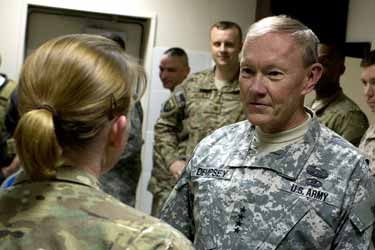
GEN Martin Dempsey meets with service members during a visit to Afghanistan in 2012. —Department of Defense Photo 
When in contact with the enemy, the individual soldier, Sailor, Airman, or Marine doesn't consider whether their comrade in arms is a man or woman. They care about whether they can do their job. There is a simple explanation for this: Trust Transcends Gender. - Resources
- More Women In Combat Roles (2013)
- Combat Rules Catching Up With Reality (2013)
- Pentagon Says It Is Lifting Ban on Women in Combat (2013)
- Panetta Lifts Combat Ban on Women (2013)
- Army Combat Integration Plan Approved (2013)
-
2014 - The Door Opens
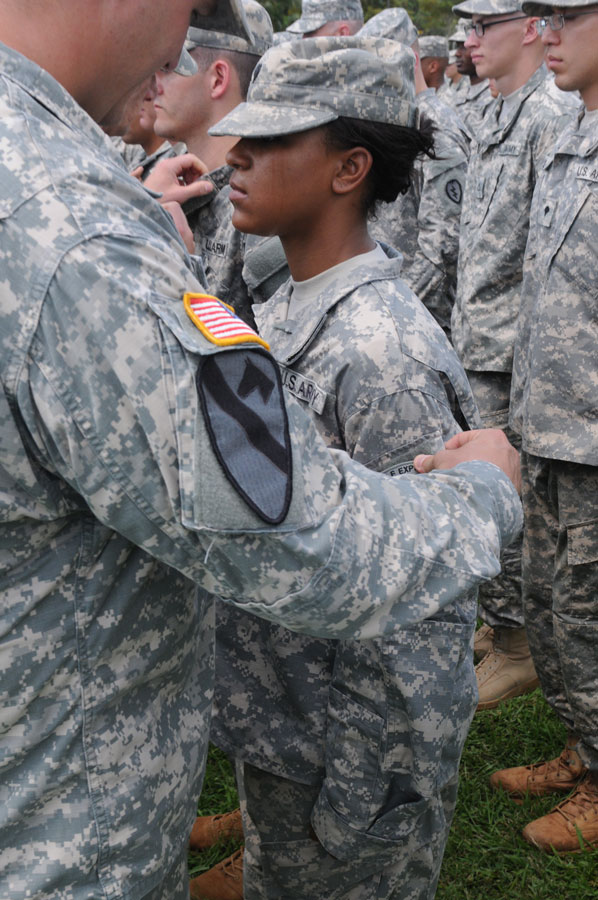
SPC Tinita Taylor became the first woman to become Jungle Warfare Qualified after passing the course in June 2014. —U.S. Army Photo While changes from the 2013 repeal of the Combat Exclusion Policy were not instantaneous, women increasingly made strides in gender integration within the Army. Female Soldiers continued to serve in harm’s way while attached to combat units in Afghanistan, including the last Cultural Support Teams (CST). In the United States, more noteworthy firsts were seen across the institution. For example, Specialist Taylor became the first Jungle Warfare Qualified woman when she graduated from the Jungle Operations Training Course. Likewise, Captain Elizabeth Rascon became the first female commander of the 1st Cavalry Division Horse Cavalry Detachment, a special ceremonial unit showcasing the division’s history and heritage.
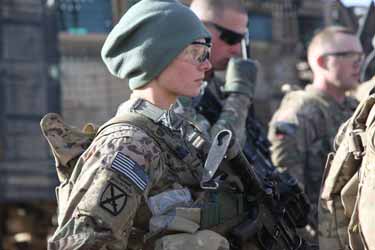
SPC Patricia Cisneros, a medic with the combat engineer unit of Alpha Company, 3rd Brigade Combat Team, 10th Mountain Division prepares for the route clearance mission in March 2014. In the next year, the first female Soldier would become a combat engineer. —U.S. Army Photo (DVIDS 1192872) 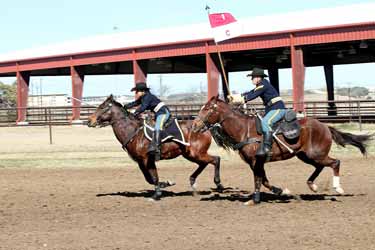
CPT Elizabeth Rascon leads a charge of 1st Cavalry Division Horse Cavalry Detachment troopers in a demonstration. —U.S. Army Photo (DVIDS 2406287) 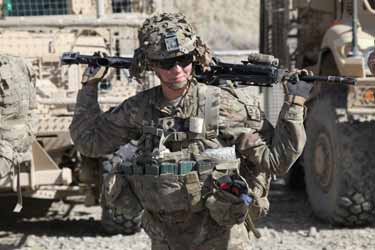
SPC Patricia Cisneros, a medic with the combat engineer unit of Alpha Company, 3rd Brigade Combat Team, 10th Mountain Division prepares to return to base after a route clearance mission in March 2014. In the next year, the first female Soldier would become a combat engineer. —U.S. Army Photo (DVIDS 1192871) 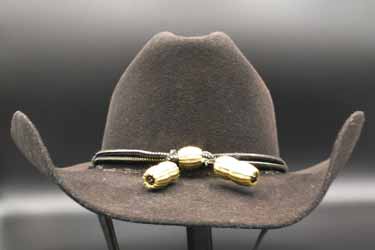
CPT Elizabeth Rascon’s cavalry hat. —U.S. Army Women’s Museum Collection - Resources
- First Female Jungle Warfare Qualified – Specialist Tinita Taylor (2014)
- Interview with SPC Taylor (2014)
- First Female Combat Engineer (2015)
- New Female Combat Engineers Training (2016)
- First Female Horse Detachment Commander (2014)
- 1st Cav’s Horse Detachment Welcomes First Female Commander (2014)
- Captain Anticipates First Cavalry Charge (2014)
-
2015 - First Female Soldiers Graduate from Ranger School

1LT Haver and CPT Griest after receiving their Ranger tab during graduation from U.S. Army Ranger School in August 2015. —U.S. Army Photo (DVIDS 2143759) In August 2015, First Lieutenant Shaye Haver and Captain Kristen Griest graduated from Ranger School, becoming the first female Soldiers to earn their Ranger tabs. Yet even as they were breaking ground by graduating from Ranger School, they could not utilize this training in the field. While the Army moved towards opening up the combat arms to female Soldiers, at the time of their graduation, Haver and Griest were not allowed to join the Rangers or serve in the infantry. However, that would change a few months later when Griest became the first female infantry officer in 2016. By 2018, both women were commanding infantry units, and as of April 2020, fifty women had graduated from Ranger School.
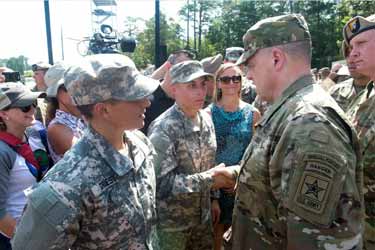
U.S. Army Chief of Staff GEN Milley congratulates CPT Griest and 1LT Haver on graduating Ranger School. —U.S. Army Photo (DVIDS 2143754) 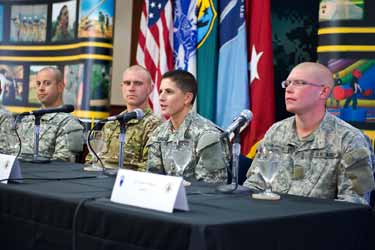
CPT Griest speaks at a panel with fellow Ranger School graduates in August 2015. —U.S. Army Photo 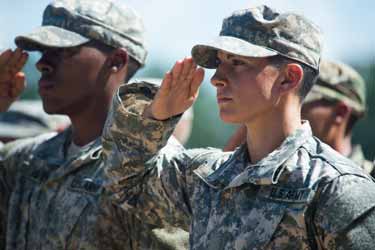
1LT Haver salutes during the graduation for U.S. Army Ranger School Class 08-15. —U.S. Army Photo (DVIDS 2143747) 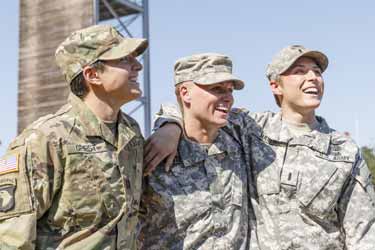
CPT Griest and LT Haver with MAJ Jaster, the third female graduate of Ranger School in October 2015. —U.S. Army Photo (DVIDS 2235312) - Resources
- First Women to attend Ranger Course (2015)
- Haver, Griest Graduate Grueling Ranger School (2015)
- Two of 19 Women Graduate Ranger School (2015)
- Ranger School Made Haver, Griest Better Leaders (2015)
- Ranger Course Student Panel (2015)
- Graduate from Army Ranger School But Can’t Fight (2015)
- Griest – Educating the Force video (2021)
- Haver- Educating the Force video (2020)
- Griest First Female Infantry Officer (2016)
- Haver Interview: Encourages Attending Ranger School (2018)
-
2016 - PFC Katherine Beatty
First Female Cannoneer (Opening of Combat Arms)
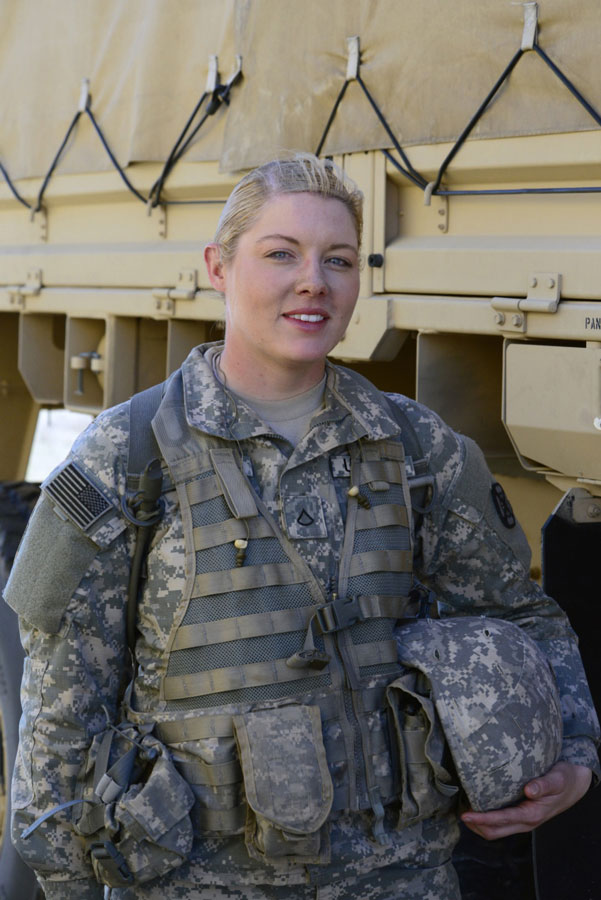
PFC Katherine Beatty became the first female 13B cannon crewmember in March 2016. —U.S. Army Photo (DVIDS 3116916) On December 3, 2015, Secretary of Defense Ash Carter announced that in January 2016, all military positions would open to women. A few months later, in March 2016, Private First Class Katherine Beatty became the first female 13B cannon crewmember in the Army. Having enlisted in a different military occupational specialty (MOS), Beatty transferred to 13B when the Army opened it to female Soldiers. Beatty graduated from her Advanced Individual Training with top honors.
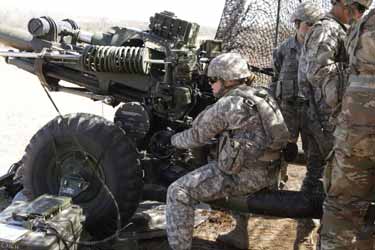
PFC Beatty fires a M119A3 howitzer as part of qualification as a Cannoneer. —U.S. Army Photo (DVIDS 3116773) 
PFC Beatty records firing data after her turn at the howitzer. —U.S. Army Photo (DVIDS 3116775) 
PFC Beatty signals her teammate during live-fire training on the M119A3 howitzer. —U.S. Army Photo (DVIDS 3116770) 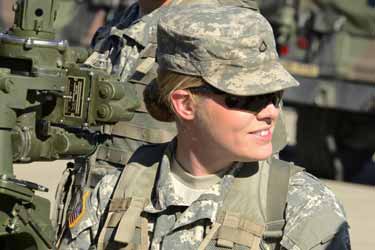
PFC Beatty trains on the M119A3 howitzer in February 2016. —U.S. Army Photo (DVIDS 3116764) - Resources
- Carter Opens All Military Occupations, Positions to Women (2015)
- PFC Beatty, Female Cannoneer (2016)
- First Female 13B Cannon Crewmember (2017)
Beatty in AIT Training at Fort Sill (2016)
- Army Opens 19,700 Field Artillery Jobs to Women (2015)
- Combat Jobs Opening to Women (2015)
-
2017 - First Gender Integrated Infantry Basic
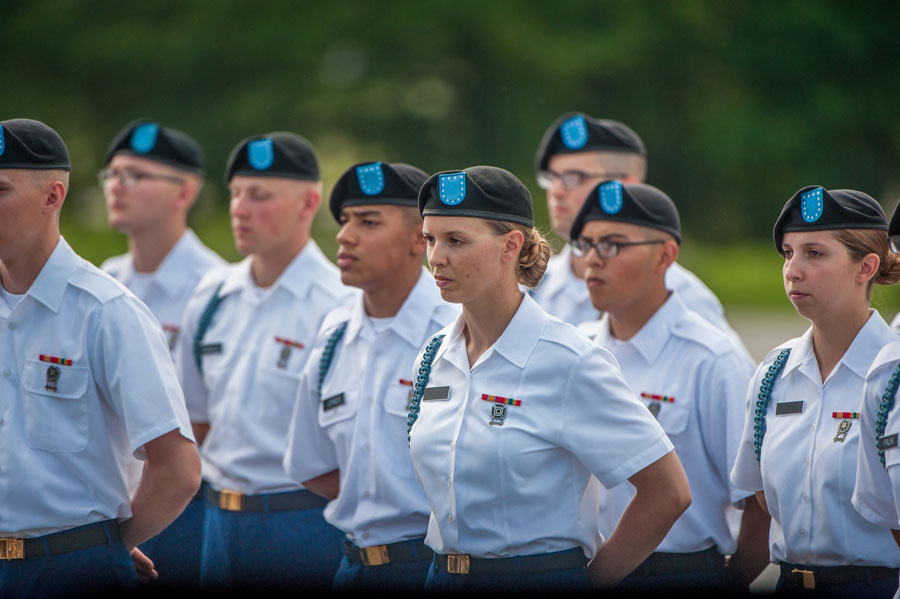
Infantry Soldiers at their “Turning Blue” ceremony where they first wear the Infantry blue cord in May 2017. —U.S. Army Photo In May 2017, the first gender integrated Infantry One Station Unit Training (OSUT) class graduated, with 18 female and 119 male graduates. Graduating from their fourteen weeks of infantry training, the female recruits were able to proudly wear the insignia of the Infantry branch. As part of the “Leaders First” policy, female officers such as Captain Kristen Griest (see entry for 2015 on timeline) and noncommissioned officers joined the combat arms to pave the way for these junior enlisted who followed.
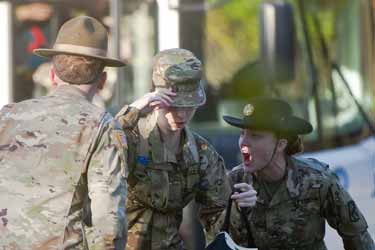
Soldiers-in-training begin their Infantry One Station Unit Training (OSUT) at Fort Benning under the watchful eyes of Drill Sergeants. —U.S. Army Photo 
Infantry soldiers-in-training work towards an objective during a training attack. —U.S. Army Photo 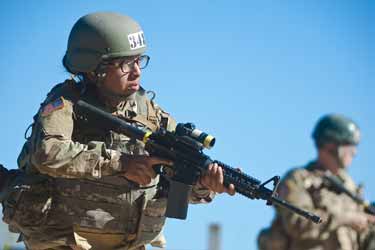
A female Infantry soldier-in-training seen during an exercise. —U.S. Army Photo 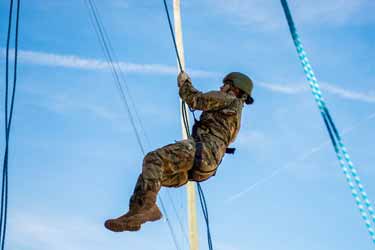
A female Infantry soldier-in-training rappels during an exercise. —U.S. Army Photo - Resources
Ft. Benning Graduates First Gender Integrated Infantry OSUT (2017)
- First Gender Integrated OSUT Graduation (2017)
- 18 Women Graduate from the Army’s First Gender-Integrated Infantry Basic Training (2017)
- Army Opens Infantry, Armor to Women (2016)
-
2018 - LTG Richardson
Acting Commander of FORSCOM
In October 2018, Lieutenant General Laura Richardson took over as the acting Commanding General for United States Army Forces Command (FORSCOM), the largest command in the Army. She was the first woman to lead FORSCOM and would serve as acting commander until March 2019. In July 2019, she became the first female commander of United States Army North and in August 2021 was confirmed to become the next Commanding General of United States Southern Command (SOUTHCOM), which will bring her fourth star, making her the second female Army 4-star general.
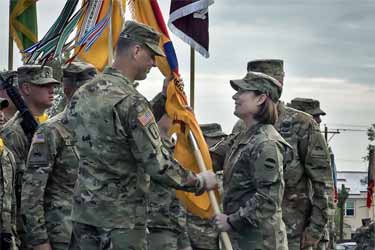
LTG Richardson at a change of command ceremony in July 2018. —U.S. Army Photo (DVIDS 4591065) 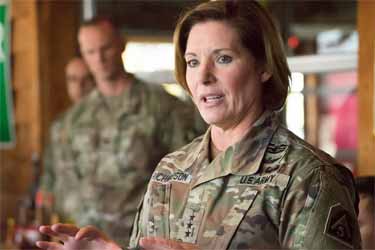
LTG Richardson talks with Soldiers in December 2019. —U.S. Army Photo (DVIDS 6000064) - Resources
- LTG Richardson Leads FORSCOM (2018)
- Richardson Confirmed as SOCOM Commander (2021)
- Dual Army Careers, Balancing Family (2019)
- When Mom Goes to War (2003)
-
2019 - Thirty Four African-American Women Graduate from West Point
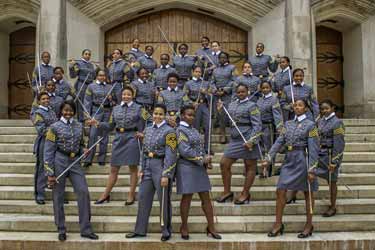
The U.S. Military Academy’s Class of 2019 graduated with 34 black female cadets, the most ever. —U.S. Army Photo 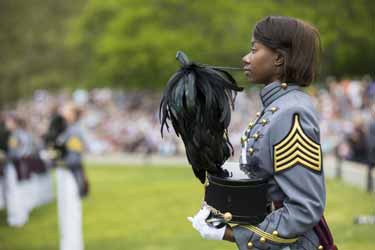
The U.S. Military Academy’s Class of 2019 graduated with 34 black female cadets, the most ever. —U.S. Army Photo (DVIDS 5473608) The U.S. Military Academy’s Class of 2019 graduated the largest number of female African-American cadets with thirty four Black female cadets being commissioned into the Army. While still a small percentage of the entire class, the numbers of women of color are rising with each passing year. West Point has put additional effort into recruiting a more diverse cadet corps. The result is more people of color, both female and male, in each graduating class. In 2017, Cadet Simone Askew became the first Black woman to become first captain of the Corps of Cadets at West Point, the highest position for a cadet.
-
2020 - First Woman Serving in the Special Forces (Green Berets)

Green Berets during a field exercise. —U.S. Army Photo (DVIDS 6734625) 
Green Berets conduct Fast Rope Insertion training. —U.S. Army Photo (DVIDS 5603768) 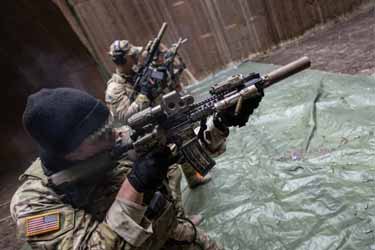
Green Berets train with small arms. —U.S. Army Photo (DVIDS 6708250) 2020 saw another first for female Soldiers, with an Army National Guard Soldier graduating Special Forces training and joining the Green Berets. The unidentified (security protocol) Soldier became the first woman to join the Green Berets, but actually the second woman to graduate Special Forces training. In 1980, Captain Kate Wilder, an intelligence officer, went through the course but was not allowed to graduate. After an investigation, Wilder was permitted to graduate but was not assigned to a Special Forces unit, and so was not considered part of the Green Berets. After this incident, women were barred from attending the qualification course until 2016, when all combat arms positions were open to women. This time around, however, things are different and the new female Green Beret is assigned to a team.
-
2021 - First Female Secretary of the Army
On May 28, 2021, Christine Wormuth was appointed Secretary of the Army, becoming the first woman to hold the Army’s top civilian position. Wormuth came to the position after an extensive career in the defense field, including serving as the Undersecretary of Defense for Policy from 2014-2016.
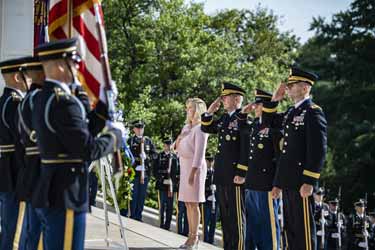
Secretary of the Army Christine Wormuth at the Tomb of the Unknown Soldier during a Wreath Laying Ceremony in June 2021. —U.S. Army Photo (DVIDS 6690956) 
Secretary of the Army Christine Wormuth seen with Soldiers of the 25th Infantry Division after seeing some Jungle Operations demonstrations. —U.S. Army Photo (DVIDS 6794952)
